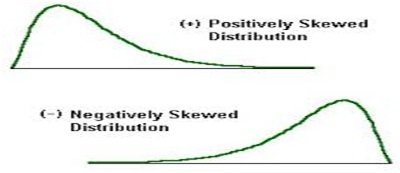- Business Concepts ›
- Statistics ›
- Positive Skewness
Positive Skewness
Definition & Meaning
This article covers meaning & overview of Positive Skewness from statistical perspective.
What is meant by Positive Skewness?
Skewness is a measure of the extent to which the probability distribution of a real-valued random variable leans on any side of the mean of the variable. A probability distribution does not need to be a perfect bell shaped curve.
The right and the left side may not be mirror images. Skewness measures this extent of asymmetry. If the data is positively skewed then it will have a much longer right tail than the left tail. In this case, mean and median will be greater than mode. In most of the cases, mean will be greater than median.
Hence,
Mean ≥ Median > Mode
Positively skewed data is also called right skewed, right-tailed, skewed to the right.
Similarly, if the data is skewed to the left then it will have a much longer left tail and the data is called negatively skewed, left-skewed, left-tailed or simply tailed to the left. Also in this case,
Mean ≤ Median < Mode
One popular measure of skewness is Pearson’s First Coefficient, which is the ratio of the difference between mean and mode to the standard deviation. If the data is positively skewed, the coefficient is positive; else it is negative for negatively skewed data. An example of positively skewed data is the life of bulbs. The smallest value can be zero, and the long life of the bulbs will make the distribution skewed towards the right.

Hence, this concludes the definition of Positive Skewness along with its overview.
This article has been researched & authored by the Business Concepts Team which comprises of MBA students, management professionals, and industry experts. It has been reviewed & published by the MBA Skool Team. The content on MBA Skool has been created for educational & academic purpose only.
Browse the definition and meaning of more similar terms. The Management Dictionary covers over 1800 business concepts from 5 categories.
Continue Reading:
What is MBA Skool?About Us
MBA Skool is a Knowledge Resource for Management Students, Aspirants & Professionals.
Business Courses
Quizzes & Skills
Quizzes test your expertise in business and Skill tests evaluate your management traits
Related Content
All Business Sections
Write for Us